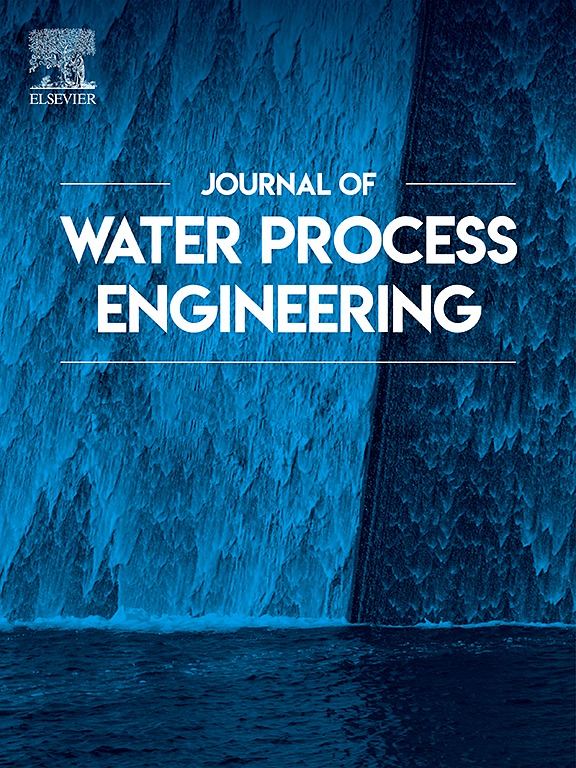Textile wastewater treatment using ternary hybrid nanocomposites of hexagonal NiO with MWCNT/GO
IF 6.7
2区 工程技术
Q1 ENGINEERING, CHEMICAL
引用次数: 0
Abstract
The persistent rise in water pollution has spurred an urgent need to develop highly effective photocatalysts to eliminate hazardous organic pollutants. Photocatalytic degradation is one of the efficient methods to achieve this. In this study, we employ a hydrothermal technique to synthesize hexagonal NiO nanoparticles, which are subsequently decorated onto multi-walled carbon nanotubes (MWCNT) and graphene oxide (GO) through an ex-situ deposition followed by ultrasonic treatment. This has resulted in the construction of binary and ternary hybrid nanocomposites. An unprecedented high efficiency is achieved by the ternary composite due to the interfacial charge transfer by the MWCNT and GO deposited. An effective decrease in electron-hole pair recombination is observed, which is confirmed by their unique structural, morphological, electronic and optical properties. A dosage of 0.5 mg/mL of NiO degrades 57.3 % percent of the reactive red 35 dye with 20 ppm concentration. Meanwhile, the ternary hybrid nanocomposite NC5G5 (NiO/MWCNT/GO) exhibits excellent photocatalytic performance of 92.7 %, under the same conditions. These results underscore the promising potential of these composites for the efficient degradation of harmful organic pollutants in wastewater treatment applications.

六方NiO - MWCNT/GO三元杂化纳米复合材料处理纺织废水
水污染的持续上升促使人们迫切需要开发高效的光催化剂来消除有害的有机污染物。光催化降解是实现这一目标的有效方法之一。在这项研究中,我们采用水热技术合成六方NiO纳米颗粒,随后通过非原位沉积和超声处理将其修饰在多壁碳纳米管(MWCNT)和氧化石墨烯(GO)上。这导致了二元和三元杂化纳米复合材料的构建。由于MWCNT和氧化石墨烯沉积的界面电荷转移,三元复合材料获得了前所未有的高效率。它们独特的结构、形态、电子和光学性质证实了电子-空穴对复合的有效减少。用量为0.5 mg/mL的NiO对浓度为20ppm的活性红35染料降解率为57.3%。同时,在相同条件下,三元杂化纳米复合材料NC5G5 (NiO/MWCNT/GO)的光催化性能为92.7%。这些结果强调了这些复合材料在废水处理应用中有效降解有害有机污染物的潜力。
本文章由计算机程序翻译,如有差异,请以英文原文为准。
求助全文
约1分钟内获得全文
求助全文
来源期刊

Journal of water process engineering
Biochemistry, Genetics and Molecular Biology-Biotechnology
CiteScore
10.70
自引率
8.60%
发文量
846
审稿时长
24 days
期刊介绍:
The Journal of Water Process Engineering aims to publish refereed, high-quality research papers with significant novelty and impact in all areas of the engineering of water and wastewater processing . Papers on advanced and novel treatment processes and technologies are particularly welcome. The Journal considers papers in areas such as nanotechnology and biotechnology applications in water, novel oxidation and separation processes, membrane processes (except those for desalination) , catalytic processes for the removal of water contaminants, sustainable processes, water reuse and recycling, water use and wastewater minimization, integrated/hybrid technology, process modeling of water treatment and novel treatment processes. Submissions on the subject of adsorbents, including standard measurements of adsorption kinetics and equilibrium will only be considered if there is a genuine case for novelty and contribution, for example highly novel, sustainable adsorbents and their use: papers on activated carbon-type materials derived from natural matter, or surfactant-modified clays and related minerals, would not fulfil this criterion. The Journal particularly welcomes contributions involving environmentally, economically and socially sustainable technology for water treatment, including those which are energy-efficient, with minimal or no chemical consumption, and capable of water recycling and reuse that minimizes the direct disposal of wastewater to the aquatic environment. Papers that describe novel ideas for solving issues related to water quality and availability are also welcome, as are those that show the transfer of techniques from other disciplines. The Journal will consider papers dealing with processes for various water matrices including drinking water (except desalination), domestic, urban and industrial wastewaters, in addition to their residues. It is expected that the journal will be of particular relevance to chemical and process engineers working in the field. The Journal welcomes Full Text papers, Short Communications, State-of-the-Art Reviews and Letters to Editors and Case Studies
 求助内容:
求助内容: 应助结果提醒方式:
应助结果提醒方式:


